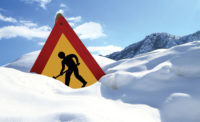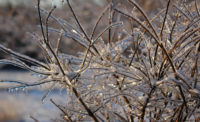During the winter, individuals working in outdoor environments face a unique set of challenges to staying safe on the job. While basic precautions — such as wearing insulating layers, covering the head and hands, and blocking wind — may seem obvious, special attention should also be paid to the ways in which we protect workers’ eyes.
Eyes are vulnerable to the elements, and their exposure to extremely cold temperatures, wind and bright light poses a variety of hazards. Eye injuries resulting from exposure to extreme cold, for instance, range from pain and blurred, decreased or double vision, to severe sensitivity to light and even vision loss. Unprotected exposure to intense glare caused by snow can lead to photokeratitis, or snow blindness, a painful corneal condition. Plus, wind chill factors can exacerbate ocular dryness, discomfort and injury.
Protecting workers’ eyes from harsh winter conditions is an important, yet easily overlooked part of an overall eye safety program. This article looks at the added precautions you should take to protect your workers’ eyes outdoors this season.
Select sealed eyewear for multi-faceted protection
OSHA calls for employers to provide employees with proper eye protection wherever hazards to the eyes exist. Such eye protection must meet the ANSI Z87.1-2010 standard for impact protection and must be marked with “Z87” on every major component. While various styles of safety spectacles meet these requirements for most indoor applications, eyewear selected for winter wear should be specialized for the unique hazards faced.
When workers face freezing temperatures, below-zero wind chills, blowing snow, airborne debris and intense glare, sealed eyewear is a must. A relative newcomer to safety eyewear offerings, sealed eyewear is a hybrid style that combines the comfort and low profile of spectacles with the added, sealed protection of a goggle. When fitted properly, the style’s foam sub-frame contours around the eyes to deliver a cushioned, customized fit and a gap-free seal that blocks wind, snow, debris and harmful rays from the eyes and surrounding skin and delicate tissue.
Many styles of sealed eyewear can be worn interchangeably with either temples or a headband, depending on the application, affording the wearer optimal versatility. To ensure all-day comfort and promote worker compliance, look for eyewear with premium comfort features. Ratcheting temples that adjust the lens angle provide a customized fit, while padding on the temples can help ensure comfortable tension and flex.
In cold applications where hats, hoods or other forms of head protection are worn, selecting sealed styles with a robust, adjustable headband option will ensure a secure back-of-head grip as well as no-slip comfort for the face.
Combat fog with effective lens coatings
Lens fogging is a leading problem faced by workers wearing any type of safety eyewear. Causes of fogging include the temperature variance between a worker’s body heat and the cold air outside, the change in temperature when workers transition from warm indoor environments to cold outdoor surroundings, and perspiration caused by exertion. When safety lenses fog, a worker’s vision becomes blurred and the risk of injury increases. To combat foggy lenses, workers may opt to remove their safety eyewear to wipe it dry or, worse yet, leave it off to avoid obscured vision altogether. Either action leaves the worker vulnerable to injury and negatively impacts productivity.
Anti-fog coatings can be very effective at reducing fog and promoting a clear view. When selecting an anti-fog coating, look for advanced solutions that are permanently bonded to the lens for long-lasting performance. While many anti-fog coatings work well right out of the box, their effectiveness may diminish over time. Look for coatings that are proven to last even after extended wear and that won’t wash off after repeated washings. Anti-fog wipes are another good solution that can be used as needed to prolong safe visibility. To further prolong lens life and an unobscured view, look for anti-fog lenses with high-performance anti-scratch properties as well.
In addition to lens coatings, sealed eyewear’s frame design can play a valuable role in combating fog. Styles with narrow, strategically located top- and side-channels will allow venting to enhance anti-fog performance while keeping out dust and debris.
Choose lens tints that reduce glare
Overexposure to bright light of any kind takes a toll on the eyes. In winter conditions, prolonged or repeated exposure to the sun’s direct rays as well as glare from snow, ice, water and other reflective surfaces can result in discomfort, eye fatigue and headaches. Likewise, prolonged exposure to the sun’s ultraviolet rays can lead to macular degeneration – a leading cause of vision loss for older Americans – as well as cataracts, skin cancer around the eyelids, corneal sunburn and other temporary and permanent vision problems.
Most safety lenses today, whether tinted or clear, deliver nearly 100-percent protection from ultraviolet rays, making their use indispensable in protecting workers’ eyes from UV hazards. But special attention should be paid to ensuring protection from glare caused by rays reflecting off of frozen or wet surfaces.
Glare is intense reflected or scattered light that causes the pupils to constrict, limiting the amount of natural light transmitted to the retina. Glare can cause discomfort, resulting in an instinctive desire to look away from a bright light source or difficulty seeing while carrying out an important task, or it can impair the vision of objects without necessarily causing discomfort.1 In either instance, glare causes workers to face increased risk of injury due to reduced visibility of nearby hazards.
While a wide variety of tinted lenses effectively reduce brightness, only polarized lenses protect specifically from glare; they also improve visual acuity through enhanced contrast. Workers outfitted with polarized lenses benefit from reduced exposure to harmful light which helps eliminate eye strain and prolongs healthy, comfortable vision.
Now that winter weather has arrived, be sure to take into account not only your workforce’s additional protective clothing needs, but also its changing eye safety needs. By providing eyewear specially designed to protect from winter hazards, you can enjoy a high standard in eye protection and productivity, even when the mercury dips.
1 https://en.wikipedia.org/wiki/Glare_(vision)



